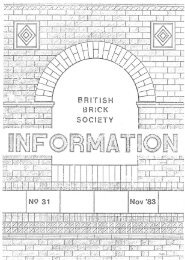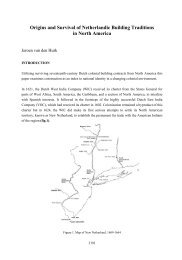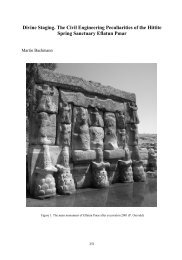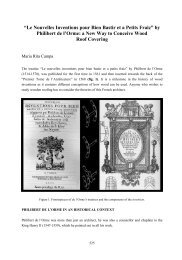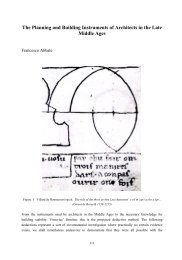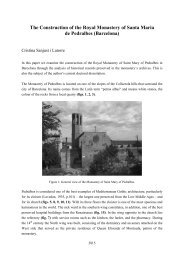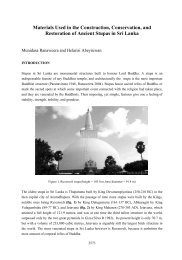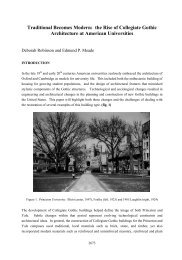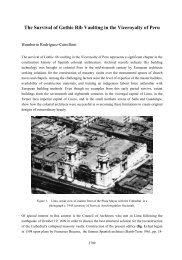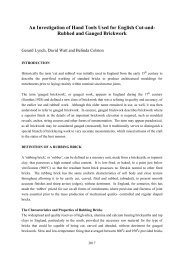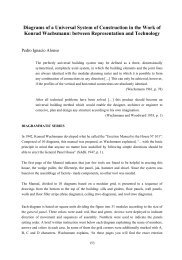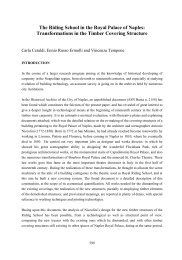Paul Bonatz and the Search for an Art - Department of Architecture
Paul Bonatz and the Search for an Art - Department of Architecture
Paul Bonatz and the Search for an Art - Department of Architecture
Create successful ePaper yourself
Turn your PDF publications into a flip-book with our unique Google optimized e-Paper software.
Being under <strong>the</strong> protection <strong>of</strong> Mörsch in a technical view me<strong>an</strong>t that no fur<strong>the</strong>r criticism about<br />
<strong>Bonatz</strong>’ <strong>the</strong>ses arose. In fact, <strong>Bonatz</strong>’ thoughts even were endorsed by Karl Schaechterle (1879-<br />
1971) <strong>of</strong> Stuttgart, <strong>the</strong> engineer who would become <strong>the</strong> central figure <strong>for</strong> bridge engineering <strong>of</strong> <strong>the</strong><br />
Reichsautobahn in <strong>the</strong> following years. Toge<strong>the</strong>r with his young assist<strong>an</strong>t Fritz Leonhardt (1909-<br />
1999), Schaechterle fully backed <strong>Bonatz</strong>’ <strong>the</strong>ses in <strong>an</strong>o<strong>the</strong>r article about motorway overpass design,<br />
which just a few months later was also published in Die Strasse (Schaechterle <strong><strong>an</strong>d</strong> Leonhardt 1934).<br />
The Design <strong>of</strong> Overpasses on O<strong>the</strong>r Motorways<br />
For underst<strong><strong>an</strong>d</strong>ing <strong>the</strong> relev<strong>an</strong>ce <strong>of</strong> <strong>Bonatz</strong>’ approach <strong>of</strong> using <strong>the</strong> visualisation <strong>of</strong> <strong>the</strong> construction<br />
as design principle <strong>for</strong> overpasses it is necessary to have a short look to <strong>the</strong> <strong>for</strong>ms <strong>of</strong> edifices <strong>of</strong> this<br />
type in Italy <strong><strong>an</strong>d</strong> <strong>the</strong> USA, <strong>the</strong> only two o<strong>the</strong>r countries that also possessed motorway-like roads at<br />
<strong>the</strong> beginning <strong>of</strong> <strong>the</strong> 1930s. The Autostrada dei Laghi (1923-25), built <strong>for</strong> connecting Mil<strong>an</strong> with<br />
<strong>the</strong> lakes in nor<strong>the</strong>rn Italy, was <strong>the</strong> first extensive project in Europe <strong>of</strong> <strong>an</strong> automobile road that<br />
showed grade separation over <strong>the</strong> whole dist<strong>an</strong>ce. Even if its overpasses, due to a road width <strong>of</strong> only<br />
8 metres, did not need <strong>an</strong>y supporting structures in <strong>the</strong>ir centre, we still c<strong>an</strong> compare <strong>the</strong> different<br />
design philosophies <strong>of</strong> this overpasses <strong><strong>an</strong>d</strong> <strong>the</strong> proposals <strong>of</strong> <strong>Bonatz</strong> <strong>for</strong> <strong>the</strong> Reichsautobahn. Framed<br />
by wing walls nearly rect<strong>an</strong>gular to <strong>the</strong> surpassing road, <strong>the</strong> sparsely subdivided structure in<br />
rein<strong>for</strong>ced concrete reminds us <strong>of</strong> <strong>the</strong> reduced <strong>for</strong>ms <strong>of</strong> <strong>Bonatz</strong>’ Lech Bridge, though its<br />
unharmonious expression c<strong>an</strong>’t be called artistic at all (Fig.6).<br />
Figure 6. Overpass on <strong>the</strong> Autostrada dei Laghi, ca. 1924 (Livini 1984, p. 52)<br />
Clearly designed with more ambition were <strong>the</strong> st<strong><strong>an</strong>d</strong>ard overpasses <strong>for</strong> <strong>the</strong> motorway between<br />
Mil<strong>an</strong> <strong><strong>an</strong>d</strong> Turin (1929-32). The bridges were now showing two more openings <strong>for</strong> giving a better<br />
<strong>for</strong>ward view <strong><strong>an</strong>d</strong> possessed a more sophisticated parapet. But, like <strong>the</strong> <strong>for</strong>mer example, <strong>the</strong>se<br />
bridges, besides <strong>the</strong>ir ra<strong>the</strong>r rough appear<strong>an</strong>ce, did not show <strong>an</strong>y artistic way <strong>of</strong> dealing with <strong>the</strong><br />
construction. Especially <strong>the</strong> haunched junction between T-beam <strong><strong>an</strong>d</strong> support did not impart a clear<br />
idea <strong>of</strong> <strong>the</strong> static system <strong><strong>an</strong>d</strong> matched almost with <strong>Bonatz</strong>’ counter-example J (Fig.7).<br />
2146



